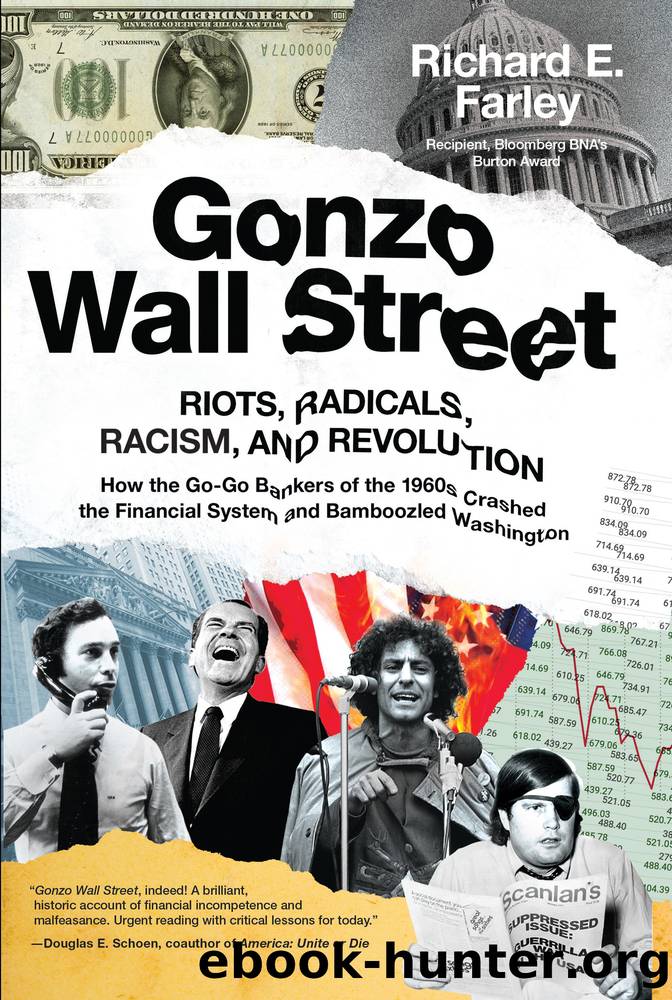Gonzo Wall Street by Richard E. Farley

Author:Richard E. Farley
Language: eng
Format: epub
Publisher: Regan Arts.
Published: 2022-08-30T00:00:00+00:00
* * *
IN THE MEANTIME, the problems at Hayden, Stone Inc. continued. On September 25, the N.Y.S.E. levied a $100,000 fine, the largest fine in history, on Hayden, Stone for failure to keep accurate records and file its financial statements in a timely way.12 Alfred J. Coyle, president of Hayden, Stone, assured the public that the companyâs problems were behind it. Coyle released a statement that the firmâs âsound financial position is reflected in its audited financial statement, filed with the N.Y.S.E. on September 18, 1969, and soon to be mailed to its customers.â13 With the fine paid, the N.Y.S.E. removed all operating restrictions it had imposed on Hayden, Stone during its investigation of the firmâs affairs. The fine, Haack hoped, would satisfy the S.E.C. And the lifting of restrictions, he further hoped, would allow the firm to improve its financial situation.
The New York Regional Office of the S.E.C., however, was most unsatisfied. It remained deeply concerned about Hayden, Stoneâs solvency notwithstanding the new clean bill of health from the Exchange.14 And its own investigation of Hayden, Stoneâs books revealed it to be in violation of the net capital rule by a substantial margin. The Exchange had allowed Hayden, Stone to include as a liquid asset, essentially as cash, for purpose of the net capital calculation an expected tax refund of over $4 million despite the fact that the Internal Revenue Service had yet to approve the refund.15 In fact, Hayden, Stone hadnât even filed its tax return claiming the refund. Kevin Thomas Duffy, the head of the S.E.C.âs New York Regional Office, was so alarmed by the lax practices of the N.Y.S.E. in enforcing the net capital rule that he wrote a letter to Hamer Budge recommending that the S.E.C. rescind the Exchangeâs net capital rule exemption and bring in-house to the S.E.C. that compliance function.16 Robert Haack didnât know about Duffyâs letter; but with it, another ball had dropped.
A fourth Wall Street firm of note fell victim to the crisis on October 13, 1969. Amott, Baker & Co. was overcome by its back-office woes. The firm, with about 7,000 customers, announced that it would be liquidating. All of its branch offices would be acquired by Charles Plohn & Co. in order âto enable us to devote all our efforts to clearing up the delivery of any securities or balances which may not have been accomplished as yet for some of our clients.â17 The board of governors of the N.Y.S.E. announced it had set aside $500,000 from the Special Trust Fund to assure all customers of Amott, Baker would be made whole. But Charles Plohn & Co., the Scanlanâs IPO underwriter and co-recipient of the largest fine ever levied by the N.Y.S.E., was hardly an ideal suitor for the shotgun marriage, as its financial condition was not much better than Amott, Bakerâs.
Download
This site does not store any files on its server. We only index and link to content provided by other sites. Please contact the content providers to delete copyright contents if any and email us, we'll remove relevant links or contents immediately.
Zero to IPO: Over $1 Trillion of Actionable Advice from the World's Most Successful Entrepreneurs by Frederic Kerrest(4052)
Machine Learning at Scale with H2O by Gregory Keys | David Whiting(3623)
Harry Potter and the Goblet Of Fire by J.K. Rowling(3608)
Never by Ken Follett(3526)
Ogilvy on Advertising by David Ogilvy(3328)
Shadow of Night by Deborah Harkness(3174)
The Man Who Died Twice by Richard Osman(2807)
Book of Life by Deborah Harkness(2718)
My Brilliant Friend by Elena Ferrante(2698)
How Proust Can Change Your Life by Alain De Botton(2613)
0041152001443424520 .pdf by Unknown(2593)
Will by Will Smith(2580)
The Tipping Point by Malcolm Gladwell(2559)
How to Pay Zero Taxes, 2018 by Jeff A. Schnepper(2500)
Purple Hibiscus by Chimamanda Ngozi Adichie(2483)
Hooked: A Dark, Contemporary Romance (Never After Series) by Emily McIntire(2420)
Rationality by Steven Pinker(2148)
Borders by unknow(2117)
Daughter of Smoke and Bone by Laini Taylor(2078)
